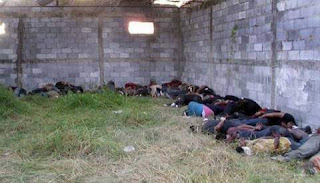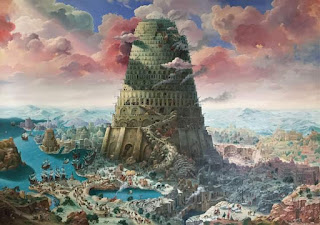"2010 San Fernando Massacre"
The 2010 San Fernando massacre, also known as the first massacre of San Fernando, was the mass murder of 72 undocumented immigrants by Los Zetas drug cartel in the village of El Huizachal in the municipality of San Fernando, Tamaulipas, Mexico.
The 72 killed—58 men and 14 women—were mainly from Central and South America, and they were shot in the back of the head and then piled up together. The bodies were found inside a ranch on 24 August 2010 by the Mexican military after they engaged in an armed confrontation with members of a drug cartel. They received information of the place after an Ecuadorian survived a shot to the neck and face, faked his death, and then made his way out of the ranch and up to a military checkout to ask for help.
There were only three survivors. Investigators later mentioned that the massacre was a result of the immigrants' refusal to work for Los Zetas, or to provide money for their release.
On 17 June 2011 the Federal Police captured Édgar Huerta Montiel alias El Wache, the major perpetrator of the mass murder. His contention was that the immigrants were killed because Los Zetas believed that they were going to be recruited by the Gulf Cartel, a rival gang. He also confessed that other bodies were put in mass graves. The immigrants were abducted from several buses, the same way others were abducted for the 2011 San Fernando massacre. The police chief that was in charge of leading the investigation of the massacre was killed by suspected members of a drug cartel.
The massacre was reported as "the biggest single discovery of its kind" in the Mexican Drug War, and as "the worst known atrocity committed by Mexico's drug trafficking organization to date". The National Alliance of Latin American and Caribbean Communities asked for those responsible "to be brought to justice for such atrocity", and Amnesty International said that this "human rights crisis" is a result of "one of the most dangerous trajectories" undocumented immigrants have to cross before reaching the United States. The Mexican drug trafficking organizations often use vacant lots, ranches, and mine shafts to keep their victims and execute their rivals. Nonetheless, in 2010, this was the largest body dumping ground found since the start of Mexico's drug war.
Moreover, the massacre caused international reactions in the United States, Ecuador, El Salvador, Honduras, Guatemala, Venezuela, Brazil, Organization of American States, Amnesty International, and the United Nations. Felipe Calderón, the president of Mexico at the time, condemned the massacre and sent his condolences to the families of those affected.
"Before the violence"
Local residents claim that arms trafficking, car thefts, and drug trade have "always existed" in San Fernando, but in 2004 Los Zetas arrived in the area. They began to establish themselves little by little, and local residents remember seeing convoys of "luxurious trucks entering and leaving the city, going into stores and buying goods". They claimed that before the Mexican Drug War (which began in 2006) and the rupture between the Gulf Cartel and Los Zetas (which happened in early 2010), the cartels "would not kidnap or steal. In fact, they would always pay for the goods they bought in stores." They would live outside the city limits in ranches. But then they began to live in city neighborhoods, and the "people started to get involved with them." A local resident claimed that many families had "at least one member involved in the drug trade", and that is why he claims many in San Fernando were scared when the violence erupted. His mother gave instructions on what to do if he is kidnapped by the cartels:
"If they come for you, do not let them take you alive. We will at least know where you are and we will have your body with us to mourn."
"Massacre"
The 72 immigrants were traveling through Tamaulipas to the United States when a convoy of Los Zetas surrounded their vehicles and cut them off the road. Then, they were forced to get out of their vehicles, and the gunmen warned them that they were members of Los Zetas. They were taken to warehouse inside a ranch, where one by one, the immigrants were put on their knees and placed against a wall. They were told to remain with their knees on the ground, and then they were shot, one by one, in the back of the head. There was one survivor—an Ecuadorian—who was shot in the neck and faked his death until the perpetrators left the area. He then traveled more than 22 kilometers until he reached a military checkpoint where he notified the Mexican marines of the area where the massacre had occurred. The man was placed under the protection of federal authorities.
When he was asked what had happened, he mentioned that they did not have money to pay for the ransom, and that the killers had forced them to work as hitmen for Los Zetas, and that they would receive over $1000 U.S. dollars every fifteen days. All of the immigrants resisted, and were consequently killed. He said that more than 70 corpses were in the ranch, and that some of the women were pregnant. At first, the authorities did not believe the survivor (since there had been similar occasions that have resulted in ambushes), but a commander of the military led an operative to the ranch were the bodies were allegedly located. When they arrived to the area by helicopter and by ground, the members of Los Zetas that were guarding the area received the Mexican authorities with bullets. The shootings lasted all day, and the Mexican military had to retreat at nighttime to the municipality of Matamoros in order to avoid a possible ambush. The next day, the Mexican military, with more personnel and ammunition, arrived at the ranch and discovered the 72 bodies. All of them were handcuffed and blindfolded.
The reports of the massacre were not officially known till later that night, since the ranch was deep inside the countryside and because the area was insecure. In the confrontations between the Mexican military and Los Zetas, 1 marine and 3 criminals were killed. The other drug cartel members managed to escape the scene. Twenty-one rifles, 101 ammunition clips, four bullet-proof vests, camouflage uniforms and four vehicles were seized by officials. The authorities also found a "replica" truck of the Mexican Naval Infantry.
"Survivor's testimony"
An 18-year-old Ecuadorian was one of the survivors of the massacre of the 72 migrants in San Fernando, Tamaulipas. According to his narrative, he went from his homeland to the country of Honduras, then traveled to Guatemala, where he stayed for 15 days. He later traveled by speedboat to Mexico, and later made it to the coastal state of Veracruz, where he was transported to Tamaulipas. On Saturday 22 August 2010 at around 10p.m., three trucks surrounded the vehicle in which he was traveling, and about eight heavily armed men got off their vehicles and took the migrants in two trucks. The migrants and Luis were then taken to a house where they remained there for a day, and then they were taken to the warehouse where the massacre occurred.
Luis explained how the migrants entered the warehouse where they were killed in a row, and once they were inside, they bandaged their eyes. They were forced to stand up for around 20 minutes, while Luis said that he thought "they were waiting for nightfall", and then they were placed with their backs on the wall. The gunmen told them to lie face down, be quiet, and not scream, because they were going to kill them if they did. "Then they started shooting", Luis said, and one of the migrants yelled that he was not scared of them. He was shot too. Everyone was shot one by one, "until it was my turn", Luis said. Then, they shot him, and Luis pretended to be dead.
After everyone was shot, the killers left the warehouse, and Luis waited around two minutes and then took off out of the warehouse. He "walked all night", and then saw a "small light far away", and made it to a house where he asked for help. Luis got to the place with a lot of pain, asking for help, but the people were scared and refused to help him. Consequently, Luis walked until sunrise, and at around 6 a.m. he saw the Mexican marines, and asked them for help.
~Credits to the rightful owners of this article.
© Wikipedia
Source: en.wikipedia.org
This is different from the 2011 San Fernando Massacre (The first one that I posted.)
Link: https://www.facebook.com/photo.php?fbid=442098193302449&set=a.316649929180610&type=3&theater
I did not include everything that is written in the article.












Comments
Post a Comment